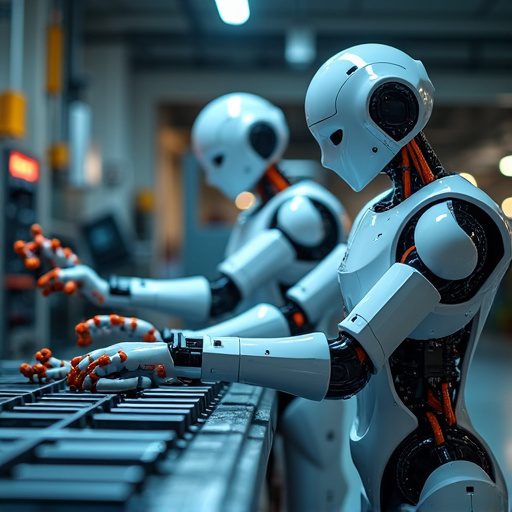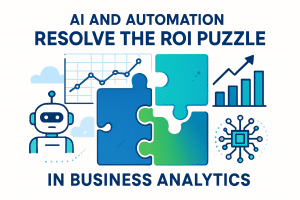Introduction
The manufacturing industry has always been at the forefront of adopting new technologies. From the industrial revolution to automation and now artificial intelligence (AI), innovation is continuously shaping how goods are produced. One of the most revolutionary advancements of the 21st century is the rise of collaborative robots (cobots). Unlike traditional industrial robots that work in isolation, cobots are designed to work alongside humans, augmenting their skills and enhancing efficiency.
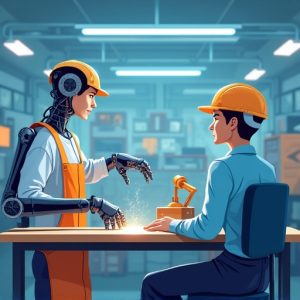
In this comprehensive blog, we’ll explore 10 real-world use cases of cobots in manufacturing, the key benefits they offer, and practical examples of their adoption worldwide.
(For more AI-driven business insights, explore AI solutions and check out our latest blogs on transformative technologies.)
What Are Cobots?
Cobots, or collaborative robots, are advanced robotic systems designed to share workspace with humans. Unlike traditional robots that require safety cages, cobots integrate safety features such as force sensors, vision systems, and smart programming, making them safe to work alongside people.
They are cost-effective, flexible, and highly scalable, making them ideal for small and medium-sized enterprises (SMEs) that previously could not afford robotics.
10 Use Cases of Cobots in Manufacturing
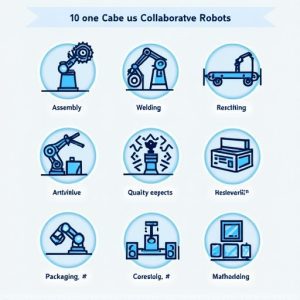
1. Assembly Line Automation
Cobots can handle repetitive tasks such as screwing, fitting, and component assembly.
-
Benefit: Reduces human error and increases consistency.
-
Example: BMW uses cobots on their assembly line to assist workers in fitting car doors, ensuring accuracy without replacing human jobs.
2. Quality Inspection & Testing
Cobots equipped with vision systems can inspect products for defects with high accuracy.
-
Benefit: Improves product quality and reduces wastage.
-
Example: A food packaging plant in Japan uses cobots to scan for damaged packaging before distribution.
3. Machine Tending
Cobots can load and unload CNC machines, injection molding machines, or 3D printers.
-
Benefit: Increases machine uptime and reduces operator fatigue.
-
Example: A US-based plastics manufacturer deployed cobots for injection molding machine tending, boosting output by 25%.
4. Material Handling & Logistics
Cobots move raw materials, tools, and products across the factory floor.
-
Benefit: Enhances worker safety by reducing manual lifting.
-
Example: DHL uses cobots in warehouses for picking and transporting items alongside human workers.
5. Packaging & Palletizing
Cobots are ideal for repetitive tasks like placing items into boxes or stacking pallets.
-
Benefit: Reduces packaging time and increases efficiency.
-
Example: Universal Robots’ cobots are widely used in FMCG companies for automated palletizing.
6. Welding & Soldering
Cobots can perform precision welding tasks with minimal supervision.
-
Benefit: Improves welding quality while protecting humans from hazardous fumes.
-
Example: Ford Motor Company uses cobots for welding, reducing error rates in vehicle production.
7. Painting & Coating
Cobots apply paint or coatings with high precision and uniformity.
-
Benefit: Reduces wastage of materials and ensures consistent surface finish.
-
Example: A furniture manufacturer in Italy uses cobots for automated spray painting, cutting down coating costs by 30%.
8. Electronics Manufacturing
Cobots handle delicate components like circuit boards and microchips.
-
Benefit: Increases accuracy and reduces product defects.
-
Example: Samsung uses cobots in semiconductor manufacturing for handling fragile wafers.
9. Healthcare & Pharmaceutical Manufacturing
Cobots assist in pill packaging, sterile lab work, and chemical handling.
-
Benefit: Reduces contamination risk and ensures compliance with safety standards.
-
Example: A pharma lab in Germany deployed cobots for filling vials during the COVID-19 vaccine production process.
10. 3D Printing & Additive Manufacturing
Cobots assist in preparing materials, cleaning, and post-processing printed items.
-
Benefit: Streamlines the additive manufacturing workflow.
-
Example: Aerospace manufacturers use cobots to handle large-scale printed parts requiring precision finishing.
Key Benefits of Cobots in Manufacturing
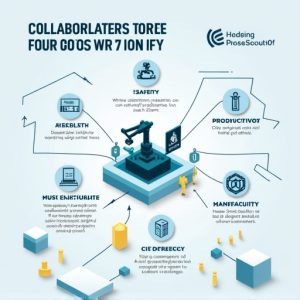
-
Enhanced Productivity – Cobots reduce downtime and keep machines running longer.
-
Improved Worker Safety – Cobots take on hazardous and physically demanding tasks.
-
Flexibility & Scalability – Easily programmable for different processes.
-
Cost-Effectiveness – Lower investment compared to traditional industrial robots.
-
Higher Quality Products – Consistency in repetitive processes ensures fewer defects.
-
Faster ROI – Most cobot investments pay for themselves within 12-18 months.
-
Seamless Human-Robot Collaboration – Workers focus on creative/problem-solving tasks.
-
Future-Readiness – Prepares factories for Industry 4.0 and smart manufacturing.
(To learn more about tech-driven efficiency, check our guide on predictive analytics software.
Real-World Examples of Cobots in Action
-
Automotive: BMW & Ford use cobots for assembly and welding.
-
Electronics: Samsung & Sony deploy cobots for micro-component handling.
-
Food & Beverages: Nestlé uses cobots for packaging chocolates.
-
Pharmaceuticals: Pfizer and Moderna deployed cobots during COVID-19 vaccine production.
-
SMEs: Thousands of small businesses now integrate cobots to remain competitive.
The Future of Cobots in Manufacturing
With the rise of AI, IoT, and machine learning, cobots will become smarter, more autonomous, and capable of predictive maintenance. Future cobots will not just assist but learn and optimize processes on their own.
(For more insights, see how AI is shaping customer service).
Final Thoughts
Cobots are no longer a futuristic concept—they are already reshaping manufacturing by enabling smarter, safer, and more efficient factories. Businesses that embrace cobots today will gain a competitive edge in productivity, cost savings, and innovation.
Whether you are a small manufacturer or a global enterprise, cobots represent the future of human-machine collaboration.
